2011 Year in Review
Earthquake Effects
We cannot even begin any reflection on the year without first considering the enormous impact of the earthquake and tsunami of March 11. It led to several high profile cancellations and postponements (including Art Fair Tokyo and Roppongi Art Night), as well as charitable efforts by galleries and organizations too numerous to list here. Many galleries also abstained from having opening receptions as strategies to reduce energy consumption amidst the setsuden hysteria.
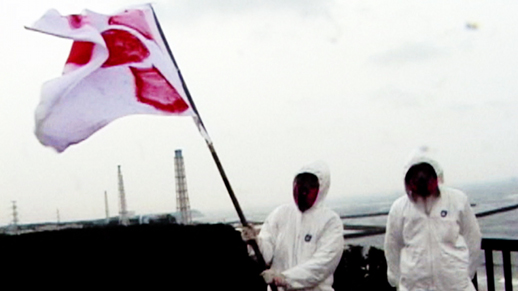
It may well be still too early for any authentic artist response and yet many have been trying. Chim↑Pom achieved the most publicity through their largely facile video and “guerilla” stunt “sabotaging” Taro Okamoto’s anti-war mural, ‘The Myth of Tomorrow’. The analogy with the Okamoto painting, far from being an attack on the establishment — since when has Okamoto been an appropriate symbol of respectability? — is also troubling for its malapropos posturing. Fukushima is, after all, an example of corporate and postwar hubris, not to mention possible government venality. Okamoto’s previously lost work is urgently pacifist in nature and its constant exploitation for cheap artistic tricks is troubling. (The short film “Blind” also made extensive use of shots including the mural.) Beyond the superficial “nuclear” similarities, the parallel simply does not hold up and merely becomes as complex as the jejune stick figures drawn by the Chim↑Pom members.
Ever since I saw them openly admit at a talk event that they had “no plan” in attempting their Hiroshima “pika!” stunt, I’ve been unable to make up my mind whether Chim↑Pom were immensely naive or just plain bad. Now I’ve started to suspect they are rather merely insincere.
Take their name. In a country such as Japan, free of Judeo-Christian guilt about sex and with essentially lolicon idols embraced into mainstream pop culture, how is it subversive or even interesting to take a name that brazenly hints at genitalia? You can be misguided, incoherent or slapdash. You may even be inept. But an artist must always be sincere if they are to be taken seriously. If I am wrong and Chim↑Pom’s work is meant in good faith, then these stunts only go so far. The question is not to go into Fukushima’s no man’s land and create reportage, as Chim↑Pom did with their videos in the exhibition “Real Times”, even if by doing so you put your health at risk. There are plenty of more qualified journalists doing the work of documentation. The issues are grave and require either responses more emotive, or more critical.
Yokohama Triennale
In any normal year the calendar would have been dominated by the Yokohama Triennale. The event (reviewed by Emily Wakeling) in Tokyo’s neighbour still managed to make headlines, though, and achieved record numbers of visitors to boot.
Compared to its more sprawling previous incarnation, the number of venues was mainly reduced to two cram-packed, conventional buildings and there was an undeniable feeling at times that famine would have been preferred to feast, especially when the overarching “theme” was so hackneyed and vapid (“Our Magic Hour”), and much of the work familiar as part of the Yokohama Museum of Art’s collection. A clutch of big names (Yoko Ono, Hiroshi Sugimoto et al) and a splash of colourful exhibits, and hey presto, you apparently have a nice day out for city slickers.
With some noble exceptions, it seems increasingly inevitable that major arts events must aim for visitors stats at the expense of compelling or challenging presentations. The role of such a triennale should be to bring new ideas and thinking to the fore, rather than recycling motifs of “senses” and “myths”. Quality should always take precedence over quantity, a cliche apparently oft forgotten by organizers and curators.
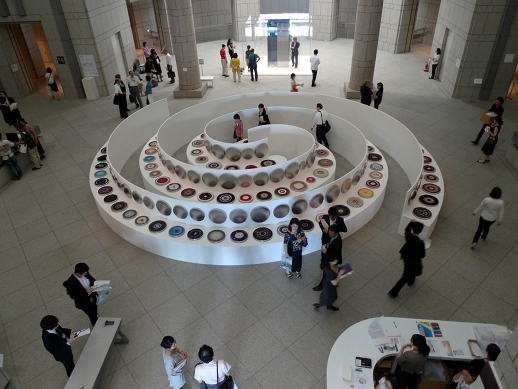
Top Exhibitions
In a year otherwise influenced so much by catastrophe, what other art events can be remembered fondly? The best response to 3.11 has likely so far been Yoko Ono’s “LIGHT” at Tomio Koyama (reviewed by Jessica Howard), with its haunting sense of bewilderment in the darkness. The ArtGigTokyo series successfully utilized innovative public spaces, including a gay club in Shinjuku and a disused hospital in Hatsudai, each site apt to its theme and curation. On the other hand, the “Villa Tokyo” event (reviewed by Emily Wakeling) saw a series of office buildings converted into temporary exhibition spaces in Kyobashi, but sadly with less obvious flair and imagination.
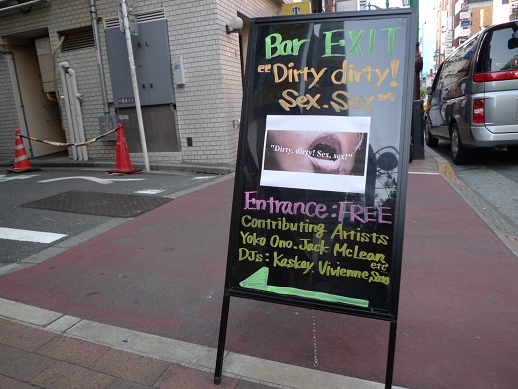
But what about the other TABlog contributors? Here are the personal favs for 2011 from three of the team.
Emily Wakeling
My personal favourites (that I didn’t review) were “Kusama’s Body Festival in the ’60s” held at Watarium, Min Wong’s “Imitation of Life” at Hara, RongRong and Inri’s “Three Begets Ten Thousand Things” at Shiseido and Tomoko Yoneda’s “Japanese House” at shugoarts. I was impressed by Chim Pom’s very quick turnaround for works about the 3.11. In May they debuted video performances at SNAC Gallery in response to the nuclear crisis, including their illicit contribution to the Taro Okamoto mural ‘Myth of Tomorrow’. Another successful piece in response to 3.11 was Australian artist Susan Norrie’s ‘Transit’ video at the Yokohama Triennale 2011. It had a slightly alarming message about the reaches of scientific progress versus the uncontrollable power of nature.
Darryl Jingwen Wee
My top 3 votes go to the Anri Sala show at Kaikai Kiki, Naoya Hatakeyama at Syabi, and the Berlin show at the MOT.
Anri Sala’s gallery debut in Japan (coinciding with a small solo showcase at the National Museum of Art in Osaka) deftly deployed Kaikai Kiki’s L-shaped space to maximum effect. Sala experimented with how sound, and the act of its articulation, can possibly be translated into visual form. ‘Long Sorrow’ laboriously traced the joyous contractions of an improv sax player’s mouth as he blew hot and cold in a riotous stutter high above a Berlin suburb, while ‘Tlatelolco Clash’ featured a fascinating cast of local Mexican residents, each offering a personalized, idiosyncratic rendition of The Clash’s ‘Should I Stay or Should I Go’ on a hand-cranked barrel organ.
Hatakeyama’s survey was a quiet but confident rejoinder to a crowded Japanese market of pop-colored painting. Standouts from the MOT’s Berlin show were definitely Simon Fujiwara’s video/installation that managed to memorialize his reticent relationship with his father in a poignant way, in addition to exploring how Berlin seems to function as a post-national space conducive to exploring issues of heritage, nationality and cultural idiom.
Dan Abbe
The 3/11 earthquake and its aftermath have made plenty of photographers look ordinary: not only photojournalists, but respected fine art photographers have visited the affected areas and been unable to come away with images that expand our understanding of what’s happening. Perhaps it’s no coincidence that some of the most compelling images to emerge so far have come from ROLLS TOHOKU, a project which puts disposable cameras in the hands of people of all ages living in evacuation centers. The resulting photographs distinguish themselves through their genuine personal connection to the disaster — something that’s kept professionals at a distance. ROLLS is nominally a web-based project, but it was exhibited at 3331 Arts Chiyoda in July, where, like its online incarnation, it was displayed as a series of unedited rolls of film.
Given that Naoya Hatakeyama’s own hometown of Rikuzentakada was one of the cities leveled by the 3/11 tsunami, it might have been reasonable to expect that his work would evince some personal reaction. Instead, it seems as though he simply worked twice as hard as any other photographer to produce the most stunning, technically meticulous photographs of the destruction so far. This work was displayed as part of his fall exhibition at Syabi, “Natural Stories,” which included photographs from his entire career showing his sensitive relationship to the earth (in the literal sense of “ground”). The Rikuzentakada photos were printed small, and incorporated into the flow of the exhibit without any fanfare. Photographs as powerful as these don’t need embellishment.
New Galleries
As with any year, Tokyo witnessed its usual array of fluctuating gallery addresses.
In the most exciting development, Zen Foto, Ota Fine Arts and Wako Works of Art, three galleries formerly in Shibuya, Kachidoki and Shinjuku respectively, moved into the same building in Roppongi, joined by a new Taka Ishii venue, Taka Ishii Gallery Photography/Film.
On the other hand, Foil Gallery in Bakurocho moved out of the capital to Kyoto, while new spaces include The Container, which was installed in a hair salon in Nakameguro.
Art Fairs
A delayed and rather subdued Art Fair Tokyo opened in the summer instead of the spring. Several major galleries did not take part and the atmosphere had an undeniably all too familiar ring to it.
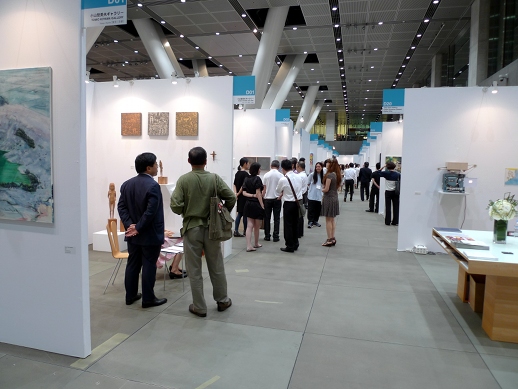
Following its debut last year, G-tokyo was held again at Mori Art Museum but successfully eschewed deja vu. Demonstrating that less is definitely more, larger “booth” spaces and an overall sense of curation made this a more enjoyable and memorable experience for the average visitor.
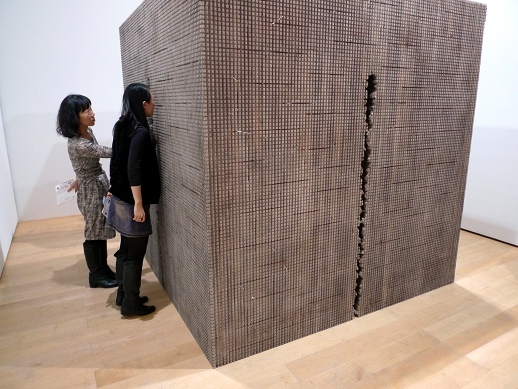
Almost simultaneous with G-tokyo 2011 was a new art fair, Tokyo Frontline, at 3331 Arts Chiyoda and provided a much more interesting use of space by an art fair than the usual suspect(s). Booths were installed in the upstairs gymnasium of the former school and all over the first floor. Fingers crossed this event can develop into a regular alternative fair.
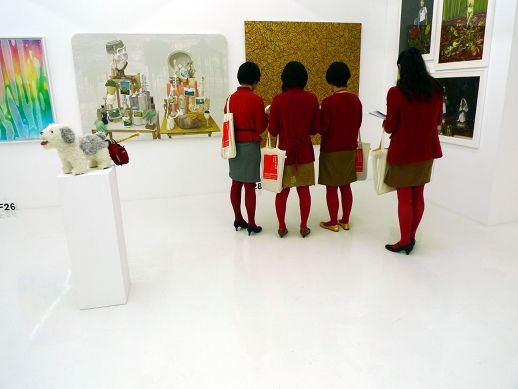
Also on TABlog…
Popular posts amongst the plethora of articles published over 2011 include our interview with media and music artist Sputniko! and with the festival director of FILMeX, Shozo Ichiyama. We also covered in-depth the recent talk event between Fumio Nanjo and Rem Koolhaas on the subject of Metabolism, and witnessed Tsubasa Kato’s participatory art event in Kiba park. Plus we reported on how artistic robots are becoming the next generation of painters, and surveyed the innovative relationship between the Japanese corporate and art worlds.
2012
What to expect for the next twelve months? Kids-friendly Roppongi Art Night is now confirmed for March next year after being cancelled in 2011, as are at least G-tokyo and Tokyo Frontline in February. Otherwise, with the Fukushima nuclear situation ostensibly stabilized, we can hopefully hold our breaths for more contemplative and thought-provoking (as opposed to merely ostensibly “provoking”) responses from local artists.
William Andrews
William Andrews



